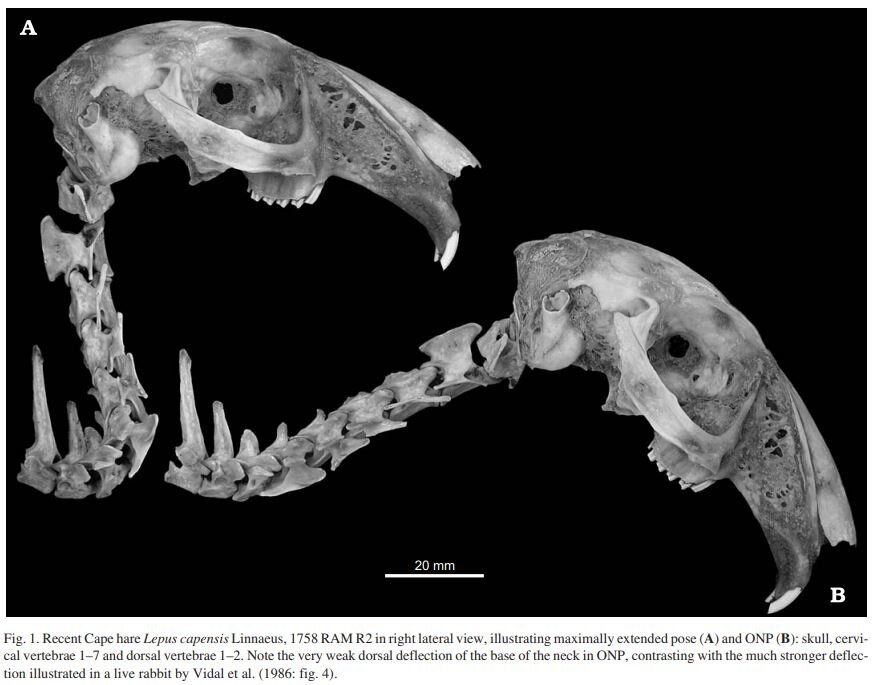Time and workload has not allowed the completion of anything new (so many new things due to appear here soon), so let’s revisit something from the archives once more. This time, the famous Nuralagus article from 2011…
Caption: life reconstruction of Minorcan giant rabbit Nuralagus rex, with Oryctolagus for scale at lower right. Image: Quintana et al./Journal of Vertebrate Paleontology; art by Meike Kohler.
Among the most intriguing of recently described fossil mammals has to be the Minorcan giant rabbit Nuralagus rex, published recently in Journal of Vertebrate Paleontology (Quintana et al. 2011). It’s a very neat discovery, whether you’re interested in lagomorph diversity or not. As usual, the one thing that everyone has been interested in is the size of this animal: how big was Nuralagus? With an estimated mass of about 12 kg, it was about ten times bigger than an average modern bunny (the examplar is of course the [ancestrally] Euro-African Oryctolagus cuniculus) and about twice as big as both the largest domestic rabbit (the Flemish) and the largest modern lagomorph of them all (the European hare Lepus europaeus).
Nuralagus is also morphologically peculiar compared to many other rabbits and hares. Relatively small eyes and small auditory bullae suggest that its senses weren’t as acute as those of continental lagomorphs, and its spreading digits, the nature of its limb bone articulations, and the low degree of flexibility in its spine all indicate that it was a relatively slow-moving walker, not a jumper or sprinter (Quintana et al. 2011).
Quintana et al. (2011) include a very nice reconstruction of Nuralagus in their paper on the animal, you might already have seen it online (it’s shown above). It’s really very good: it shows the animal to scale with a European rabbit, and portrays it in nice, realistic fashion. But... they almost certainly have the neck horribly wrong.
Caption: for our work on dinosaur neck pose, we articulated the neck vertebrae of various living animals using the dry bones alone. At right (B) you can see what happens when you articulate rabbit vertebrae in this way. Yet we know from x-rays of live rabbits that substantially more flexibility is present in life; a rabbit with its neck in ‘life pose’ looks like what’s posed at left (A). This figure is from Taylor et al. (2009).
They show the neck skeleton of Nuralagus held just about straight, in a strange, sub-horizontal pose, and with no curve in it whatsoever. I presume they did this because they imagine that’s how extant rabbits hold their necks. In fact – as you’ll know if you followed the neck posture stuff I published with Mike P. Taylor and Mathew Wedel (Taylor et al. 2009) – it definitely ain’t so. Like rodents and other ‘short necked’ mammals, rabbits actually have a strongly curved neck skeleton that descends sharply close to the cervico-thoracic transition before ascending to meet the occiput. None of this is at all obvious in the living animal and is only revealed in x-ray (or when other imaging techniques are applied). It’s surprising, but it’s really there: rabbits have a virtually S-shaped neck skeleton… check out the x-ray of a live rabbit below, from Vidal et al. (1986).
Regardless of whatever preconceptions you might have, we really should assume by default that the neck of this weird, giant, island-endemic rabbit was also S-shaped, with a strong curvature just like seen in extant rabbit species. And it’s no use saying that the fossil bones won’t allow this sort of posture, since one of the things that’s obvious from x-rays of living animals is that the postures their necks maintain during life aren’t readily reproducible from dry bones either. The soft tissues present in the living animal make the neck skeleton more flexible that is the case in the dry skeleton, not less.
Finally (this bit of text wasn’t included in the original 2011 text you’ve just read), my contention about the look of the Nuralagus neck as published by Quintana et al. (2011) inspired John Conway to produce a ‘straight-necked rabbit’ reconstruction for our 2012 book All Yesterdays. I later reconstructed Nuralagus myself (hopefully accurately) for my in-prep textbook, and a good number of Nuralagus reconstructions have appeared online more recently, many of which make a point of giving it a conventional rabbit-like neck posture.
Caption: at left, John Conway’s straight-necked rabbit, here as portrayed in a magazine article by Natasha Umer. At right, my own reconstruction of Nuralagus from an as-yet-incomplete mega-project.
We’ll end there. This is a reduced version of the original article which doesn’t include the long section on rabbit phylogenetics featured in the original. You can see the original here.
For previous TetZoo articles on rabbits, see…
The most freaky of all mammals: rabbits, May 2006
News from the World of Rabbits, July 2016
You can support this blog and my other projects here at Patreon!
Refs - -
Quintana, J., Köhler, M. & Moyà-Solà, S. 2011. Nuralagus rex, gen. et sp. nov., an endemic insular giant rabbit from the Neogene of Minorca (Balearic Islands, Spain). Journal of Vertebrate Paleontology 31, 231-240.
Taylor, M. P., Wedel, M. J. & Naish, D. 2009. Head and neck posture in sauropod dinosaurs inferred from extant animals. Acta Palaeontologica Polonica 54, 213-220.
Vidal, P. P., Graf, W. & Berthoz, A. 1986. The orientation of the cervical vertebral column in unrestrained awake animals. Experimental Brain Research 61, 549-559.









